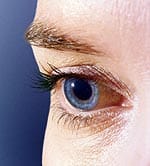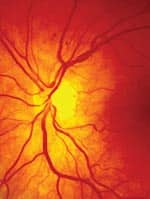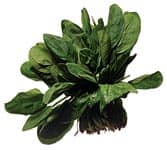Life Extension Magazine®
Lutein, a natural yellow colorant or pigment belonging to the carotenoid family, is widely distributed throughout the plant and animal kingdoms. Carotenoids are found in dark green leafy vegetables, some fruits, corn, and even egg yolk. Plant pigments, including carotenoids, are vital to human health because of their antioxidant properties, which help in removing dangerous free radicals from our bodies. Controlling free radicals contributes to the slowing of aging and various disease processes. Different antioxidants perform their work in different parts of the body, and lutein is known to be particularly important to the eyes. Lutein acts to filter out blue light, a highly energetic wavelength of the visible light spectrum. Blue light is thought to induce free radical damage in human organs that are exposed to it, including the eyes and skin. Blue light is different from the commonly referred to ultraviolet A and ultraviolet B wavelengths. Like many other important health-related compounds, lutein is not manufactured in the body. The only way to obtain it is by consuming foods rich in this antioxidant or by supplementing with lutein. In the body, lutein is found in the skin’s outer (epidermis) and inner (dermis) layers, the eyes, cervix, brain, liver, lung, prostate, blood serum, and breast. Lutein acts in these tissues as an antioxidant and filter of blue light.
Lutein is often found with its stereoisomer, or mirror image chemical, zeaxanthin. Lutein accounts for roughly 11% of the carotenoids found in the bloodstream. In fatty tissue, lutein makes up nearly 20% of all carotenoids. In nature, lutein is often found esterified, or joined together, with fatty acids. Lutein is sometimes listed as xanthophyll. While xanthophyll is considered to be identical to lutein, some sources differentiate the two, as xanthophyll belongs more formally to a class of carotenoids that contain oxygen. Lutein is distinct from beta-carotene, the precursor of vitamin A. In plants, lutein and other xanthophyll-type carotenoids assist in the first step of photosynthesis that involves capture of light photons.1 In humans, birds, and other primates, lutein is highly concentrated in the macula lutea, a yellowish spot close to the center of the eye’s retina, where precision vision occurs. In dietary supplements, lutein is found in two different forms—as crystals in an oil suspension, or in powder form containing lutein esters—and is well absorbed at amounts of up to 20 mg per day. How Lutein Promotes Eye HealthAntioxidants have various effects on different organ systems, and lutein seems to be an especially powerful protector of eye health. Lutein and zeaxanthin are the two most abundant carotenoid pigments in the human eye. Specifically, they are found in the macula and retina, where focused vision takes place.2 Increasing one’s dietary intake of lutein raises blood serum levels of lutein and increases the density of pigment in the macula.3 Lutein offers protection against the two most common causes of vision loss: cataracts and age-related macular degeneration. A cataract is an opacity of the lens of the eye, of its capsule, or both. Cataracts become increasingly prevalent with age, and are the principal cause of mild to moderate visual impairment. Epidemiological evidence suggests that low levels of lutein intake are associated with an increased risk of cataracts.4 Increased macular pigment optical density has been associated with a decrease in lens optical density, suggesting that lutein and zeaxanthin may retard aging of the eye lens.5 In addition to its role in preventing cataracts, lutein may improve vision in people who already have cataracts. When patients with age-related cataracts supplemented with lutein, their visual acuity improved.6 Lutein appears to play a role in the prevention and treatment of age-related macular degeneration, the most common cause of severe visual impairment and blindness. Epidemiological evidence suggests that increased lutein intake is associated with a decreased risk of developing age-related macular degeneration.2,7 Additionally, lutein may improve vision in patients who already have macular degeneration. A clinical trial in 2004 demonstrated that supplementation with 10 mg of lutein daily in patients with age-related macular degeneration increased macular pigment optical density and improved glare recovery, contrast sensitivity, and vision acuity, thus improving overall visual function.8 Other clinical research suggests that lutein may also be useful for another disease of the eye known as retinitis pigmentosa. Retinitis pigmentosa is an inheritable genetic disease that eventually leads to diminished night and peripheral vision. When patients with retinitis pigmentosa supplemented with lutein for 26 weeks, their visual acuity improved. Interestingly, this improvement was greater in blue-eyed people than in those with darker-colored eyes.9 Possible Role in Cancer PreventionVarious natural carotenoids, including lutein, have been shown to exhibit anticarcinogenic activity.10 The protective properties of carotenoid compounds may be due in part to their ability to reduce the accumulation of oxidative damage. Dietary intake of lutein has been found to influence not only serum levels of lutein, but also lutein levels in breast tissue.11 Lower blood levels of carotenoids, including lutein, have been correlated with an increase in breast cancer risk.12 This suggests dietary and supplemental carotenoid intake may be preventive against breast cancer. Lutein in high dietary doses may also protect against colon cancer. Researchers at the University of Utah examined the incidence of colon cancer in relation to dietary intake of carotenoids. They found that greater dietary intake of lutein from sources such as spinach, broccoli, lettuce, tomatoes, oranges, carrots, celery, and greens was associated with a lower risk of colon cancer in both men and women.13
How Much Should I Take?Most people in the US are deficient in lutein. Low intake of lutein is more common in men, smokers, and those who consume more than two alcoholic beverages a week. Higher intake of lutein is generally found among women, older people, and those with high blood pressure. Research on optimal amounts suggests that consuming 6-20 mg of lutein daily is required to obtain a health benefit. To reduce the risk of cataracts and age-related macular degeneration, many nutritionally oriented practitioners recommend 6 mg of lutein daily. For relief of symptoms associated with age-related macular degeneration, a dose of 10 mg per day of supplemental lutein has been shown to be effective.8 Commercial preparations of lutein, which are derived mainly from the petals of marigold flowers, are typically available in either 6- or 20-mg dosages. Lutein supplements are better absorbed when taken with a high-fat rather than low-fat meal.14 While some commercial multivitamins now include small amounts of lutein among their ingredients, research suggests that the very small doses provided in these multivitamins (usually 0.25 mg) are likely to have negligible health benefits. As noted earlier, increasing one’s dietary intake of lutein increases blood serum levels of lutein.3 Foods that contain the highest concentrations of lutein, such as broccoli, spinach, and kale, are associated with the most beneficial effects on eye health.15,16 Dark green leafy vegetables usually contain lutein in amounts ranging from 15% to 47% of their total carotenoids. Corn is one of the foods richest in lutein, which accounts for 60% of corn’s total carotenoids, while orange peppers are richest in zeaxanthin at 37% of total carotenoids. Kiwi contains large amounts of both lutein and zeaxanthin. A cup of kale supplies 44 mg of lutein, a cup of spinach offers 26 mg of lutein, and a cup of broccoli has 3 mg of lutein. Consumption of eggs that have been enriched with lutein and zeaxanthin will lead to greater amounts of lutein in the blood compared to consuming a similar amount (6 mg) of lutein from spinach.17 Lutein-enriched eggs come from chickens that have been fed marigold petals.
Interactions and ContraindicationsNo adverse reactions have been reported in subjects taking lutein. Purified, commercially available lutein has attained GRAS (Generally Recognized As Safe) status in the US for supplementation at doses of up to 20 mg daily. An interesting study showed that on the island of Fiji, lutein consumption ranges from 18 to 23 mg per day—significantly higher than the suggested daily intake of 6 mg—with no adverse side effects. The study authors suggested that this high lutein intake may be partly responsible for the lower rates of cancer in the Fijian population.18 A series of experiments assessing the safety of lutein on laboratory animals was performed over periods of 4 and 13 weeks.19 Daily doses ranging from 2.6 to 773 mg per kilogram of body weight were administered for 4 weeks, and daily doses of 2.6 to 260 mg per kilogram of body weight were administered for 13 weeks. At the end of trial, investigators found no significant differences in growth, blood chemistry, or tissue health in the two groups of animals studied.
When taken with beta-carotene, the absorption of lutein may be hindered while the absorption of beta-carotene may be enhanced.20 Lutein has no known interactions with drugs. No adverse reactions have been reported when taking lutein with other diseases or conditions, and no effects on medical laboratory tests have been noted. When taken with olestra, a fat substitute found in some snack foods, lutein concentration is lowered in circulating blood.21 (Although the FDA has approved olestra as a food additive, foods containing this artificial fat should be avoided entirely. Olestra is believed to cause abdominal cramping and loose stools, and is known to inhibit the absorption of some vitamins and other nutrients.) ConclusionLutein is a novel antioxidant with health-promoting effects on the organs of the eye, namely the retina and macula. Daily ingestion of moderate amounts (6-20 mg) of this carotenoid yields benefits in disease conditions such as age-related macular degeneration, cataract formation, and possibly retinitis pigmentosa. Other uses for lutein, including its potential role in cancer prevention, are currently under investigation. | |||||
| References | |||||
| 1. Bungard RA, Ruban AV, Hibberd JM, Press MC, Horton P, Scoles JD. Unusual carotenoid composition and a new type of xanthophylls cycle in plants. Proc Natl Acad Sci USA. 1999 Feb 2;96(3):1135-9. 2. Bernstein PS, Zhao DY, Sharifzadeh M, Ermakov IV, Gellerman W. Resonance Raman measurement of macular carotenoids in the living human eye. Arch Biochem Biophys. 2004 Oct 15;430(2):163- 9. 3. Johnson EJ, Hammond BR, Yeum KJ, et al. Relation among serum and tissue con- centrations of lutein and zeaxanthin and macular pigment density. Am J Clin Nutr. 2000 Jun;71(6):1555-62. 4. Alves-Rodrigues A, Shao A. The science behind lutein. Toxicol Lett. 2004 Apr 15;150(1):57-83. 5. Berendschot TT, Broekmans WM, Klopping-Ketelaars IA, Kardinaal AF, Van Poppel F, Van Norren D. Lens aging in relation to nutritional determinants and possible risk factors for age-related cataract. Arch Opthalmol. 2002 Dec;120(12):1732-7. 6. Olmedilla B, Granado F, Blanco I, Vaquero M. Lutein, but not alpha-toco- pherol, supplementation improves visual function in patients with age-related cataracts: a 2-y double-blind, placebo-con- trolled pilot study. Nutrition. 2003 Jan;19(1):21-4. 7. Mitchell P, Smith W, Cumming RG, Flood V, Rochtchina E, Wang JJ. Nutritional fac- tors in the development of age-related eye disease. Asia Pac J Clin Nutr. 2003;12 Suppl:S5. 8. Richer S, Stiles W, Statkute L, et al. Double-masked, placebo-controlled, ran- domized trial of lutein and antioxidant supplementation in the intervention of atrophic age-related macular degenera- tion: the Veterans LAST study (Lutein Antioxidant Supplement Trial). Optometry. 2004 Apr;75(4):216-30. 9. Dagnelie G, Zorge IS, McDonald TM. Lutein improves visual function in some patients with retinal degeneration: a pilot study via the Internet. Optometry. 2000 Mar;71(3):147-64. 10. Nishino H, Murakosh M, Ii T, et al. Carotenoids in cancer chemoprevention. Cancer Metastasis Rev. 2002;21(3-4):257-64. 11. Yeum KJ, Ahn SH, Rupp de Paiva SA, Lee-Kim YC, Krinsky NI, Russell RM. Correlation between carotenoid concen- trations in serum and normal breast adi- pose tissue of women with benign breast tumor or breast cancer. J Nutr. 1998 Nov;128(11):1920-6. 12. Tonioli P, Van Kappel AL, Akhmedkhanov A, et al. Serum carotenoids and breast can- cer. Am J Epidemiol. 2001 Jun 15;153(12):1142-7. 13. Slattery ML, Benson J, Curtin K, Ma KN, Schaeffer D, Potter JD. Carotenoids and colon cancer. Am J Clin Nutr. 2000 Feb;71(2):575-82. 14. Roodenburg AJ, Leenen R, van het Hof KH, Westrate JA, Tijburg LB. Amount of fat in the diet affects bioavailability of lutein esters but not of alpha-carotene, beta-carotene, and vitamin E in humans. Am J Clin Nutr. 2000 May;71(5):1187-93. 15. Pratt S. Dietary prevention of age-related macular degeneration. J Am Optom Assoc. 1999 Jan;70(1):39-47. 16. Brown L, Rimm EB, Seddon JM, et al. A prospective study of carotenoid intake and risk of cataract extraction in US men. Am J Clin Nutr. 1999 Oct;70(4):517-24. 17. Chung HY, Rasmussen HM, Johnson EJ. Lutein bioavailability is higher from lutein- enriched eggs than from supplements or spinach in men. J Nutr. 2004 Aug;134(8):1887-93. 18. Le Marchand L, Hankin JH, Bach F, et al. An ecological study of diet and lung cancer in the South Pacific. Int J Cancer. 1995 Sep 27;63(1):18-23. 19. Kruger CL, Murphy M, DeFreitas Z, Pfannkuch F, Heimbach J. An innovative approach to the determination of safety for a dietary ingredient derived from a new source: case study using a crystalline lutein product. Food Chem Toxicol . 2002 Nov;40(11):1535-49. 20. Kostic D, White WS, Olson JA. Intestinal absorption, serum clearance, and interac- tions between lutein and beta-carotene when administered to human adults in sep- arate or combined oral doses. Am J Clin Nutr. 1995 Sep;62(3):604-10. 21. Koonsvitsky BP, Berry DA, Jones MB, et al. Olestra affects serum concentrations of alpha-tocopherol and carotenoids but not vitamin D or vitamin K status in free-living subjects. J Nutr. 1997 Aug;127(8 Suppl):1636S-5S. |





